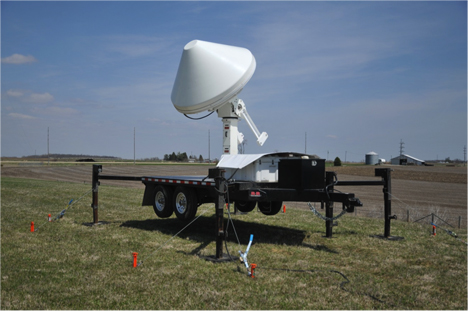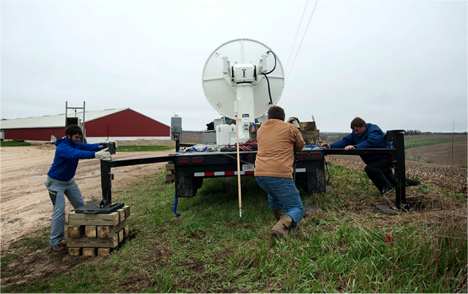Finding a location for two of the four University of Iowa XPOL radars was easy. They will remain at their current home base locations near Iowa City and Cedar Rapids overlooking the Clear Creek Watershed for the IFloodS campaign. For the other two destined for the Turkey River basin in northeast Iowa — well, there was work to be done.
As is typical, finding the “ideal” radar locations proved to be challenging. The primary goal was simple enough — a high spot with a good view. Then we add in the need for power, communications, and access, and it becomes more complicated.

The Turkey River basin, unaltered by glaciers, is rugged and hilly by Iowa standards. Lots of great views, but the ruggedness that makes some of the land difficult to farm, and also means there are a lot of obstructions on the tops of hills, namely tall trees. This image is the “radar’s eye “ view from the St. Olaf site and demonstrates why it was chosen. Credit: Iowa Flood Center
After much planning, looking at satellite images, talking with local cities and groups, it was time to visit the basin for a reality check. Many sites that had appeared so promising became distant memories, but new possibilities arose with help of local individuals from the City of Decorah, the City of Calmar, local IDNR staff, Northeast Iowa Community College, and others. We are grateful for their “touring the countryside” time and cooperation. In the end, two very attractive locations were secured, one in Calmar and one south of St. Olaf.

April 30, 2013, Calmar site: The XPOL installation at Calmar went smoothly enough. It was very windy, but sunny, with mild temperatures. For the follow-up installation of the communications, we dealt with very windy conditions and ice-covered surfaces. Credit: Iowa Flood Center

May 2, 201, St. Olaf Site: The St. Olaf installation was a bit better, 38 degrees F (warm??) , overcast, and very windy, with rain all day. Visiting scholar Jacopo Grazioli, Dan Ceynar, and Radek Goska of the Iowa Flood Center adjust the radar position on the cribbing. Credit: Iowa Flood Center
As many visiting researchers and NASA and scientist are now fully aware, the weather in Iowa is constantly changing, often between extremes. The weather during the installation of the XPOL radars was challenging, ranging mostly from cold, windy, and rainy to windy and icy. Very challenging indeed. Tenacity prevailed, and both new radar locations were successfully installed at the beginning of the month despite the adverse weather conditions.
From May 1 to June 15, NASA and Iowa Flood Center scientists from the University of Iowa will measure rainfall in eastern Iowa with ground instruments and satellites as part of a field campaign called Iowa Flood Studies (IFloodS). They will evaluate the accuracy of flood forecasting models and precipitation measurements from space with data they collect.
Dan Ceynar is a staff engineer at the Iowa Flood Center. He coordinates many of the Iowa Flood Center’s instrumentation networks across Iowa including stream sensors, rain gauges, and XPOL radars. This spring, he has been busy working with NASA and IFC staff to deploy instruments for the IFloodS campaign.



